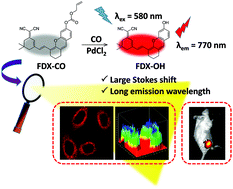The construction of a near-infrared fluorescent probe with dual advantages for imaging carbon monoxide in cells and in vivo†
Abstract
As a kind of toxic gas, carbon monoxide (CO) can hinder uptake of oxygen in humans. However, more and more studies have shown that CO is an important gaseous messenger in the body and playing an indispensable role in intracellular signaling pathways. So, it is necessary to develop an analytical method to study CO in living organisms. Although there are many CO-responsive probes, most of them have the disadvantages of a small Stokes shift or short emission wavelength. In order to address the above issue, a novel probe (FDX-CO) with a large Stokes shift (190 nm) and long emission wavelength (770 nm) was firstly synthesized to detect CO. The probe shows high sensitivity and superior selectivity toward CO. Moreover, the probe was successfully used for visualizing exogenous and endogenous CO in cells by fluorescence imaging, 3D quantification analysis and flow cytometric analysis. More importantly, FDX-CO could excellently detect CO in mice, which suggests that this probe has the potential ability to image CO in vivo. This probe can be viewed as a useful tool in the research of CO.



 Please wait while we load your content...
Please wait while we load your content...